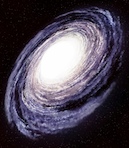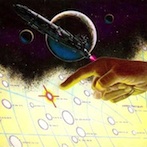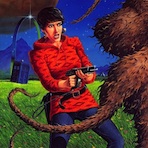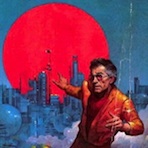complimentary copy provided by the publisher.
February 6th, 2002
"Perhaps no other character dialogue exemplifies so well what is fundamental to understanding van Vogt, the man, and his work. As Grosvenor [from The Voyage of the Space Beagle] expresses the raison d'etre of his nexialism, readers are presented with the epitome of a Socrates-Plato dialogic syndrome in van Vogt's story. Grosvenor is not just a character mouthing fictitious dialogue; he was the alter ego of the real A.E. van Vogt! I believe that through Grosvenor, van Vogt said what he really thought about people, places, and situations in the real world around him."
That was just a brief snippet from A.E. van Vogt: Science Fantasy’s Icon an excellent new non-fiction book by H.L. Drake, published in e-book format and print-on-demand by Booklocker.com. It is a rare treat indeed when a new work comes out relating to Van, since books of this nature are few are far between. The last one in English I know of was A Reader’s Guide to A.E. van Vogt by J. M. Elliot, published years and years ago and was so poorly distributed that it remains virtually unknown. Not so with Drake’s book; with the internet, the most obscure things are equally available to all, and an e-book need never go out of print.
When I was first approached to write a review of this book, I was enthusiastic but approached it with a bit of trepidation. My view of literary critics is anything but high; they often readily dismiss things worthy of further study, and what they do study they tend to draw out strange — and at times ridiculous — symbolism and allegories out of a hat and apply them to whatever takes their fancy. (For instance, interpreting an alien invasion as an allegory of man’s search for inner meaning and so on.) Fortunately, I was pleasantly surprised when, after a few pages into Drake’s book, I found instead an intelligent study of Van’s works and interests, and not an English critic’s dissertation.
To quote from the last chapter in the book, Drake’s goal is to "offer a better understanding of A.E. van Vogt by presenting some of his personal life interests as they related to select and representative works." And this is exactly what he does, and he doesn’t waver from that goal. Van Vogt is famous, if not notorious, for his interest in "fringe sciences" and how he incorporated ideas derived from these systems into his stories and novels. Drake starts out with a brief biography of Van, and goes on to study a wide variety of van Vogt's novels and stories. But it's not all analysis; there is much useful and interesting information including rare details on van Vogt's screenplay for a proposed film of Slan and about the outline to Slan II, as well as the background behind the writing of Null-A Three.
Drake and Van shared an interest in General Semantics, and Drake interviewed him several times over three decades on this and other subjects. These interviews, van Vogt's works, and others' analyses of van Vogt's works form the foundation for the content in this book. Drake draws from each of these three resources to substantiate — and often give an alternate view to — his own analyses. Given their mutual interest in Korzybski's theories, it is understandable that the bulk of the book is given to studying instances of General Semantics philosophies in van Vogt's corpus — indeed, throughout the book he draws attention to several instances of that philosophy not only in the Null-A stories but in many other works (such as The Voyage of the Space Beagle), far more than I even suspected. For instance, he gives details on the 1951 revision of Slan, and compares it to the 1940 original, highlighting how General Semantics (though not clearly labeled as such in the novel) trickled into even the most famous of van Vogt's fantastic tales. It is fascinating little facts like this that make one realize and appreciate how deeply Van was involved in thinking about General Semantics and other commonly derided, often crazy, but sometimes perceptive philosophies.
But General Semantics is by no means the only philosophy studied. I was surprised to learn that the very strange "twenty-decimal" similarization technique of travel employed by Gilbert Gosseyn was in fact inspired by John W. Campbell. I'd always been intrigued by this idea, as bizarre and impossible as it is, and was glad to see Drake devote a few paragraphs to the topic. Much room is also given to the "violent male" model of human male behavior, William Bates' system for improving eye-sight, and even explanations for why Van used the words "gray" and "drab" so often in his writing.
As stated in the introduction, he avoids an overly academic writing style that often leads more to confusion than clarity, for which I at least am grateful. The sentences are kept short and factual, but with the always-welcome occasional touch of humor. This book is not only an invaluable reference for anyone interested in Van and his works, it is also a pleasant read. Mr. Drake has also done a massive amount of research to write this book; the 15-page bibliography is an immense treasure-trove of articles and books on related topics so anyone is sure to find information on their favorite aspect of van Vogt's interests and stories.
In short, to give you some idea of how important I think Mr. Drake's book is to the study of A.E. van Vogt — the man, his interests, and how he portrayed them in his stories — I would like to say that after carefully reading Mr. Drake's book, I have re-evaluated the way I read van Vogt. And that is not an easy thing to get me to do.
A brief note here: if you buy the book, I'd recommend the paperback. I have the PDF e-book version, and to read it I printed out the whole bally thing and had to put it in a big 3-ring binder. Suffice to say, I can't fit the 3-ring binder on my book-shelf! But on the other hand, the PDF is ideal for searching for specific information, since the book has no index. At any rate, I'd recommend it highly — in either of its forms, or even both — to anyone who reads van Vogt.







